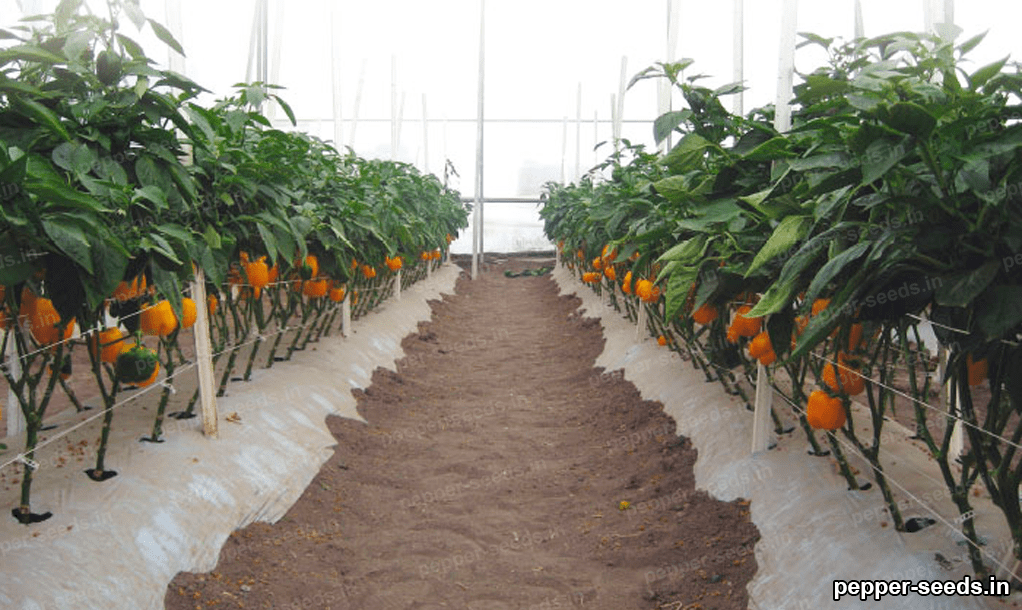Pepper is a particularly delicate crop plant. Given its size and stature, it needs a special kind of care to thrive optimally.
One way to keep the crop secure is to use a support with trellising netting. The support netting supports stems and fruits that lack sufficient protection and support due to their size. The use of a trellising net can help prevent potential problems such as frost damage, broken or crushed fruit, and obfuscated or unevenly growing plants. This results in a better harvest, as the fruit is protected and yields are increased.
To apply the trellising netting, first spread the netting over the main stems of the plant. This is done approximately one foot or 30 centimeters away from the plant. Then, we will anchor the edges with a shovel and stones or other materials. We will proceed to roll and smooth the netting tightly to prevent it from unfolding. If there are gaps in the mesh, we have to generate additional tension to prevent the mesh from unfolding on its own in strong winds.
fter placing the netting, we recommend providing additional support by reinforcing the staking with stakes, hangers, etc. These supports minimize stress for heavily loaded stems or large crops. Ensure firmly anchoring these structures to the soil for effective netting function.
Care should also be taken to ensure that the trellising netting does not become dusty. Subtraction of sunlight will limit the growth and production of your crops. If you already have an extensive screen, it is best to use a mop to clean it regularly. Alternatively, we can also use a blower if it is clean enough for deep cleaning. Finally, we can always remove the screen as needed to remove debris.

Safety measures provided by a trellising netting for pepper crops.
Pepper trellising netting is an essential element for the success of any agricultural project. This netting is used to provide plant protection and to support the beds used to increase production. Pepper crop trellising netting also functions as a refuge for social organisms present in the field that feed on nutrients from soil microorganisms.
The trellising net is a flexible plastic mesh with small holes, usually 3 to 4 cm in diameter. This netting is connected with small clips to sturdy metal rods that support the beds. This netting offers the advantage of facilitating crop irrigation while providing protection against pests and diseases, and controlling the mechanics and rooting of the plant.
The trellising netting is an essential safety measure in pepper crops. The netting shields the plants from external pressures, such as wind or rain, ensuring successful cultivation processes. It also prevents the spread of diseases among the crop, reducing the risks of disease transmission across the field.The correct use of the netting also allows for greater resistance to wind and the effects of erosion, thus extending its life and maintaining its good condition.
In addition, trellising and bedding netting largely prevents field eradication. This means that even during periods of drought, agricultural soils remain sufficiently moist to produce quality crops. The netting also helps to maintain the essential nutrients present in the soil, which are necessary for high crop yields and quality.
It is also important to note that trellising netting helps prevent dangerous field work. The netting prevents the bedding mound from crumbling, which reduces the risk of injury.

Relevance of protecting a crop with trellising netting.
Crop protection with tutorage netting has proven to be an efficient and safe method of crop protection, which allows obtaining a good crop yield and minimizing damage caused by external agents. This technique consists of covering the crop with a synthetic mesh, which prevents the entry of pests, predators and birds. In addition to protection, it offers other benefits such as improved air quality and drought prevention.
One of the main benefits of crop protection with trellising netting is the increase in crop yield. By covering the crop area, the amount of pests is reduced, which translates into higher yields and lower incidence of crop diseases. This protection is also important to avoid the direct impact of rain and wind on crops, in addition to minimizing insect damage. In addition, the material can be reused over and over again, saving resources and gaining efficiency. On the other hand, an important element to highlight is the safety that this technique provides for farmers in terms of preventing damage by wildlife and birds.

One of the main challenges farmers face today is to reduce the use of pesticides and pesticides.
This protection technique significantly reduces the need to apply chemicals to crops by providing a natural barrier against external factors. This benefits farmers, the environment and consumers by avoiding the harmful effects of pesticides on food.
In addition to increased yields and reduced pesticide use, crop protection with trellising netting also provides improvements in air quality. This type of material is characterized by its permeability, which allows air and sunlight to enter the crops. This permeability favors the development of a healthy ecosystem in the cultivation area, as it regulates the passage of air and provides nutrients. This ventilation improves air quality and prevents the effect of drought.
Crop protection with trellising is a highly effective technique for farmers in terms of increasing yields and reducing the use of pesticides. Moreover, this technique is safe for food production, for the environment and for consumers. Finally, it remains an interesting alternative for the improvement of air quality in growing areas. For all these reasons, crop protection with trellising has proven to be an important tool to obtain better results in agricultural production.